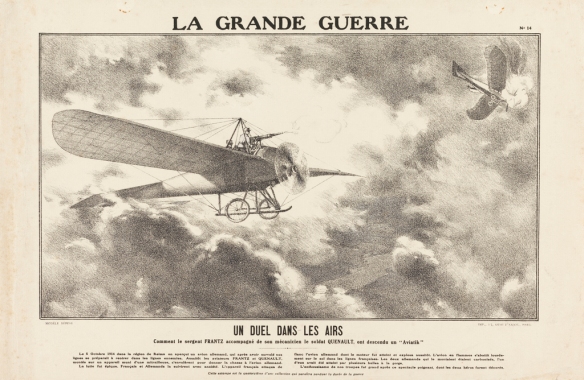On 5 October 1914, French Corporal Louis Quénault downed a German Aviatik while firing a Hotchkiss gun from the observer’s seat in a Voisin III pusher piloted by Sergeant Joseph Frantz. Louis Quenault would be the first to actually shoot down an enemy plane in mid air with a blast of gunfire.
October 5, 1914, Sergeant Joseph Frantz (born in 1890, died in Paris in 1979) and his mechanic Louis Quénault (dates unknown), were attached to flotilla V 24. Flying a Voisin Type 3 biplane, they fired on a German Aviatik with a Hotchkiss machine gun. It was being piloted by Sergeant Wilhelm Schlichting with Lieutenant Fritz von Zangen as his observer. They were engaged in a reconnaissance mission close to Jonchéry on Vesle. After they exhausted the ammunition for the machine gun, they found themselves being fired upon by the German observer with his rifle. Sergeant Quénault responded with his own rifle and one of the shots hit the pilot. The plane, out of control, crashed to the earth and was destroyed. This event marked the first confirmed air victory of the First World War, and indeed in History at the same time.
There had been occasional exchanges of shots between the pilots of planes during the first weeks of the conflict, but Frantz and Quénault are credited with being the first aviators to shoot down an enemy plane.
Following this event, and in light of the subsequent victories which followed, the French high-command became aware of the new role which aviation could play when units specialized not only in observation and bombardment, were fitted with armament suitable for battle between planes in the air.
At the very start of the war French Voisin and Farman pushers shared the skies over the Western Front with tractor reconnaissance aeroplanes such as the British BE 2 and the German Albatros B II. Then in late August 1914 some airmen decided to stop sharing and start shooting.
The quest for control of the skies was initially pursued in one of three ways – mounting a machine gun to fire above or around the propeller; devising a means of synchronising the weapon with the engine so it only fired when the prop was not in the way; and literally avoiding the problem by putting the engine behind the machine gun. The last, seemingly simplest, method lent the pusher aeroplane a renewed martial validity. Indeed, it led to a series of Allied pusher fighters that were able to hold their own against their German counterparts – including the Fokker Eindeckers, with their synchronised machine guns – until 1917, when the gap in performance between them and their tractor-engined counterparts became indisputably hopeless.
Until then, pushers made history. The first destruction of an aeroplane in air-to-air combat using firearms was achieved from the nacelle of a French Voisin 3LA on 5 October 1914. Belgium’s first ace scored his first five victories in two-seat pushers. Britain’s first production fighter, the Vickers FB 5 Gunbus, earned one of its pilots a Victoria Cross (VC), and made such an impression in 1915 that when in doubt the Germans referred to nearly every British pusher they encountered as a ‘Vickers’.
In mid-1916 Maj Lanoe G Hawker’s No 24 Sqn, with its Airco DH 2s, became the first single-seat fighter unit in the Royal Flying Corps (RFC). DH 2s were involved, directly or indirectly, in the deaths of pioneer German aces Otto Parschau and Oswald Boelcke, and of Staffelführer Stefan Kirmaier – and, on the debit side, in the rise of his most famous protégé, the future ‘Red Baron’ Manfred von Richthofen. One DH 2 pilot, Lionel W B Rees of No 32 Sqn, also earned the VC.
The most successful pushers of them all, however, were large two-seaters built by the Royal Aircraft Factory – the FE 2b and FE 2d. Even as late as mid-1917, their crews were demonstrating how deceptive their ungainly appearance was, with exploits that included the valour that earned Fit Sgt Thomas Mottershead a posthumous VC. Moreover, ‘Fees’ were credited with killing German aces Hans Berr, Max Immelmann, Gustav Leffers, Karl-Emil Schafer, Kurt Schneider, Alfred Ulmer and Ernst Wiessner, and with wounding the ‘Red Baron’ himself.
